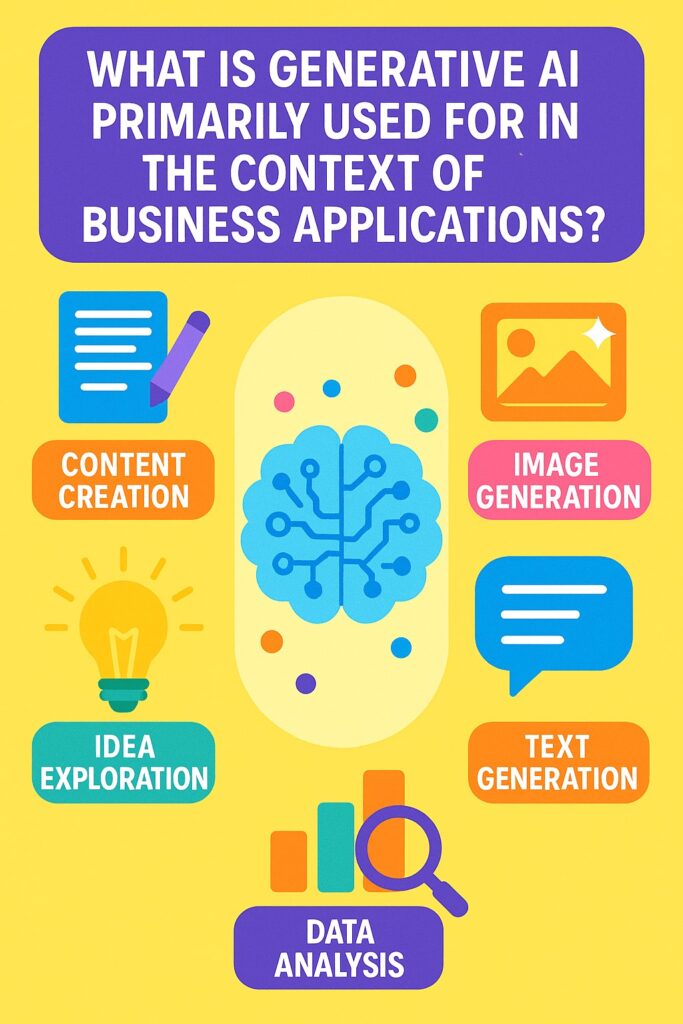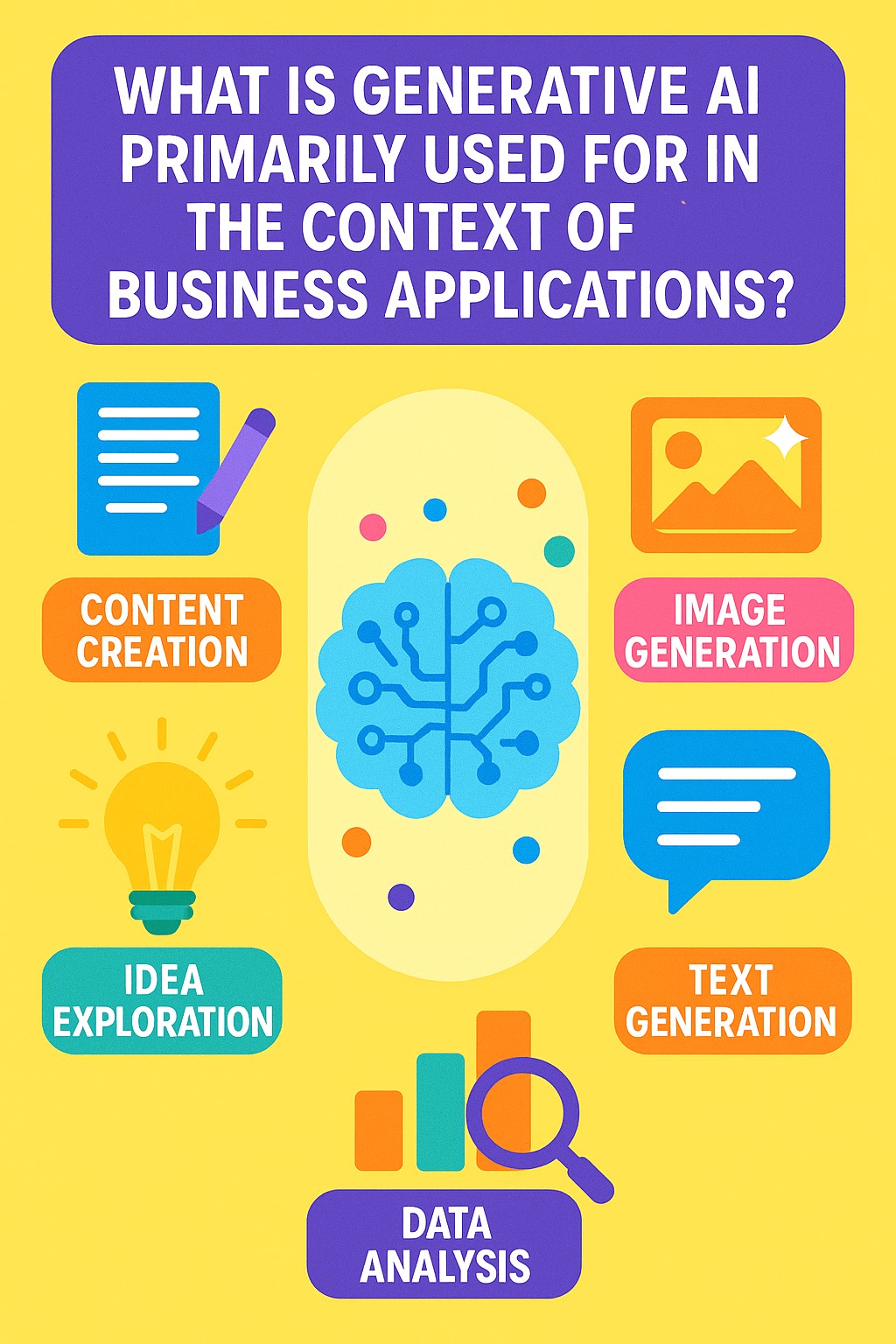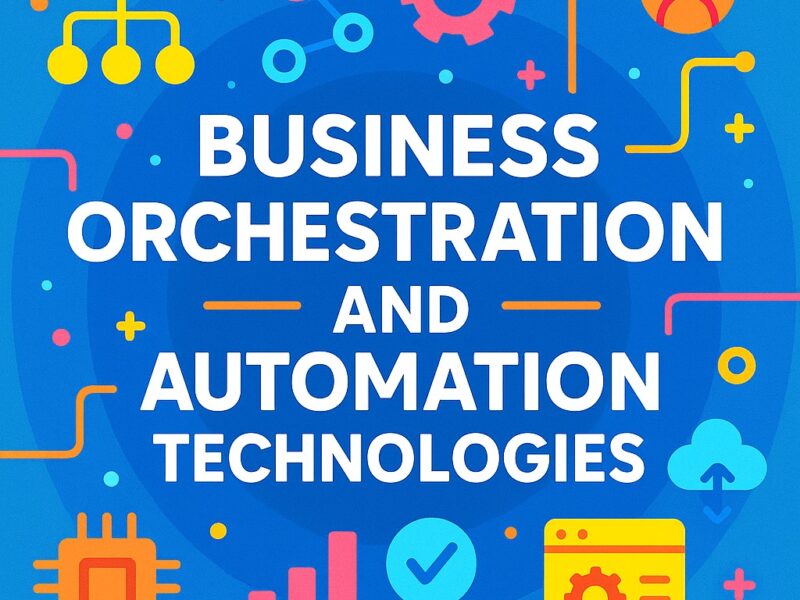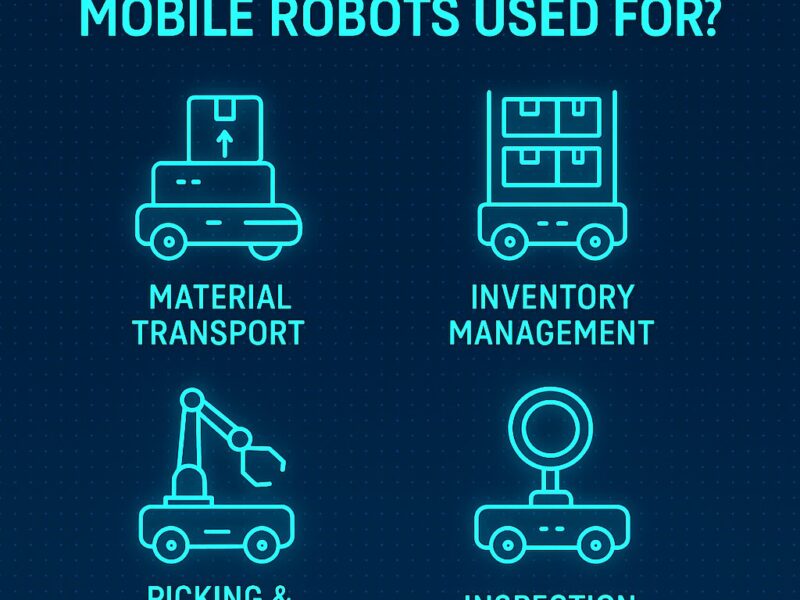What Is Generative AI Primarily Used For In The Context Of Business Applications

Generative AI has emerged as a transformative force in the business world. It enables companies to automate tasks, boost productivity, and create content with unprecedented speed and accuracy. But beyond the buzz, what is generative AI primarily used for in the context of business applications? This article explores the key uses of generative AI across industries, with practical examples and clear explanations that reveal how it creates real value in business environments.
Enhancing Content Creation at Scale
One of the most recognized uses of generative AI in business is content generation. Businesses constantly need new content to maintain their digital presence—be it on websites, blogs, product pages, or social media. Generative AI tools can write compelling articles, generate product descriptions, compose promotional emails, and even assist with drafting reports or presentations.
For example, marketing teams often rely on AI to generate dozens of email variations for A/B testing, cutting down time while improving personalization. In publishing or ecommerce, generative AI can automatically produce descriptions for thousands of items based on product specifications, helping scale content production without hiring more writers.
This ability to quickly create high-quality, SEO-friendly content helps businesses remain competitive in fast-moving markets.
Automating Customer Support with AI Chat Systems
Another major application is in customer service. Generative AI powers chat-based systems that interact with customers in real-time. These AI-powered chat agents understand queries, respond appropriately, and escalate more complex issues to human agents when needed.
Many businesses deploy generative AI chat interfaces on their websites, apps, or internal systems to reduce wait times and enhance customer satisfaction. These systems can handle frequently asked questions, process refunds, or help users troubleshoot issues without any human intervention.
Moreover, they are available 24/7, ensuring businesses remain accessible to clients regardless of time zones.
Personalizing User Experiences
Personalization is a powerful marketing tool—and generative AI takes it to the next level. By analyzing user behavior, demographics, and preferences, AI can create tailored messages, product recommendations, and even custom landing pages for individual users.
For instance, a fashion retailer can use generative AI to generate outfit suggestions based on a customer’s past purchases, style preferences, or even current weather conditions in their location. Similarly, AI can craft personalized email messages based on user interactions with a website or previous campaigns.
This type of deep customization boosts engagement and conversion rates, which directly impacts a company’s bottom line.
Designing Visual and Multimedia Content
Generative AI isn’t just about text—it also produces images, audio, and video content. In business applications, this opens doors to scalable design solutions. Marketing teams, for instance, can generate branded visuals, banner ads, infographics, or promotional videos using AI-driven design tools.
Real estate companies may use generative AI to enhance property images, while product-based businesses can create virtual mockups or lifestyle visuals. With AI models trained to follow brand guidelines, teams can generate content without needing graphic designers for every task.
This reduces design bottlenecks, speeds up campaign deployment, and supports brand consistency.
Improving Product Development and Prototyping
Generative AI plays a key role in product design and prototyping. Engineers and designers use it to brainstorm new ideas, create prototypes, or simulate product performance. AI models can propose multiple design variations, taking into account cost, materials, functionality, and aesthetics.
For example, in automotive or consumer electronics, engineers might use generative AI to optimize the shape or structure of a component for performance and efficiency. This reduces time to market and minimizes development costs.
The same applies in software development, where AI can help generate code snippets, suggest architecture layouts, or even automate testing procedures.
Accelerating Market Research and Competitive Analysis
In business strategy, data is critical. Generative AI is now being used to interpret complex datasets and generate readable reports. Instead of spending days analyzing spreadsheets, decision-makers can ask an AI system to generate summaries, forecasts, or strategic insights.
These systems can also help in analyzing competitors, generating reports on market trends, and suggesting potential growth areas. For instance, a business analyst might prompt a generative AI model to compare two markets and create a presentation on which one offers the most promise for expansion.
By turning raw data into actionable insights, generative AI reduces the cognitive load on teams and speeds up decision-making.
Enabling Internal Process Automation
Beyond customer-facing roles, generative AI is being integrated into internal business processes. This includes automating documentation, generating training materials, or streamlining onboarding experiences.
Human resources teams can use AI to write job descriptions, create candidate summaries, or generate customized training manuals. Legal departments may use it to draft contract templates. Finance teams might use it to generate monthly summaries or detect anomalies in transactional data.
These applications reduce the manual workload and ensure consistency in internal documentation, making operations smoother and more efficient.
Supporting Language Translation and Localization
As businesses expand globally, they often need content translated into multiple languages. Generative AI can help by not just translating, but localizing content to fit cultural nuances and tone.
For example, a brand expanding into Latin America may use AI to generate Spanish-language product listings that feel native, rather than directly translated. This boosts customer trust and engagement in new markets.
The same applies to customer support, where multilingual AI systems can help teams provide seamless experiences to global users without hiring large translation teams.
Generating Business Ideas and Innovation Concepts
AI is also used as a brainstorming partner. Businesses can prompt generative AI systems to propose ideas for new products, marketing angles, or business models. Because AI can draw from vast datasets and patterns, it sometimes offers ideas that humans might not immediately consider.
Startups and innovation labs often use this approach during their ideation phases. They prompt AI to simulate what a future consumer might want, or to predict how industry trends may evolve. This helps spark innovation while reducing the early friction of creative development.
Boosting Data Analysis and Reporting
Generative AI is increasingly used to make sense of business data. It can summarize customer surveys, turn spreadsheets into executive dashboards, and even forecast future trends using historical information.
Instead of manually compiling monthly reports, teams can use AI to auto-generate readable summaries with visuals, charts, and explanations. These insights support faster and better-informed business decisions.
Companies in finance, logistics, sales, and retail benefit greatly from this application, as it turns overwhelming data into useful business intelligence.
Conclusion
So, what is generative AI primarily used for in the context of business applications? As shown throughout this article, the range is vast—from content generation and customer service to design, strategy, and innovation. Businesses leverage generative AI to save time, cut costs, personalize experiences, and stay competitive in a digital-first world.
The future will likely see even deeper integration of AI into business functions. As these technologies improve, companies that adopt generative AI wisely will gain a major advantage in efficiency, creativity, and market responsiveness.
Key Takeaways: What Is Generative AI Primarily Used For In The Context Of Business Applications?
-
Scalable Content Creation: Generative AI enables businesses to produce large volumes of written content quickly, including blog posts, emails, product descriptions, and reports.
-
Automated Customer Service: AI chat systems provide 24/7 customer support, handling routine inquiries and improving response times without human agents.
-
Hyper-Personalized Marketing: Businesses use generative AI to create personalized messages, recommendations, and experiences based on user behavior and data.
-
Multimedia Content Generation: AI helps design visuals, videos, and marketing assets, reducing reliance on design teams and speeding up campaign creation.
-
Product Development Assistance: Designers and engineers use generative AI to prototype new products, optimize components, and simulate performance scenarios.
-
Faster Market and Competitive Analysis: AI interprets complex data, summarizes trends, and provides business insights that support smarter decisions.
-
Internal Operations Automation: Teams in HR, legal, and finance use generative AI to draft documents, write training materials, and automate routine tasks.
-
Global Reach Through Language Support: AI translates and localizes content for international markets, ensuring cultural relevance and broad accessibility.
-
Business Innovation & Idea Generation: Generative AI is used as a brainstorming partner, offering fresh ideas for products, services, and strategies.
-
Enhanced Data Reporting: AI transforms raw data into executive-ready summaries, visual reports, and actionable insights for leadership teams.
These applications demonstrate that generative AI is not just a novelty—it is a powerful, practical tool that helps businesses operate more efficiently, connect with customers, and innovate in a competitive landscape.
References
https://en.wikipedia.org/wiki/Generative_artificial_intelligence
Links License – https://en.wikipedia.org/wiki/Wikipedia:Text_of_the_Creative_Commons_Attribution-ShareAlike_4.0_International_License
Friends, warmly welcome you to visit link below for more technology articles. Enrich you knowledge and enjoy reading.
https://techsavvo.com/category/blog/


